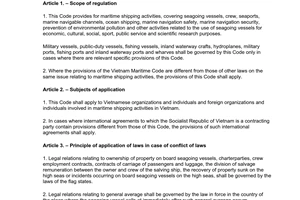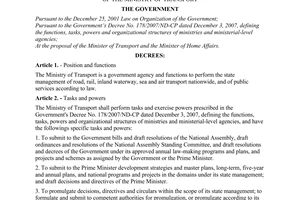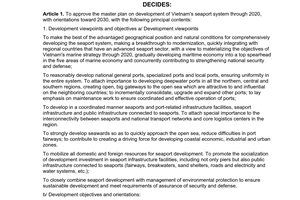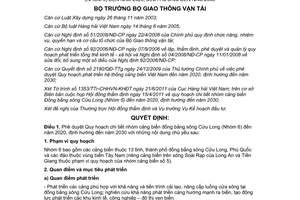Nội dung toàn văn Decision No. 1746/QD-BGTVT approving the detailed master plan on the seaport
|
THE
MINISTRY OF TRANSPORT |
SOCIALIST
REPUBLIC OF VIET NAM |
|
No. 1746/QD-BGTVT |
Hanoi, August 03, 2011 |
DECISION
APPROVING THE DETAILED MASTER PLAN ON THE SEAPORT GROUP IN THE MEKONG RIVER DELTA (GROUP 6) THROUGH 2020, WITH ORIENTATIONS TOWARD 2030
THE MINISTER OF TRANSPORT
Pursuant to the November 26, 2003 Construction Law; Pursuant to the June 14, 2005 Maritime Code of Vietnam;
Pursuant to the Government’s Decree No. 51/2008/ND-CP of April 22, 2008, defining the functions, tasks, powers and organizational structure of the Ministry of Transport;
Pursuant to the Government’s Decree No. 92/2006/ND-CP of September 7, 2006, on elaboration, appraisal, approval and management of socio- economic development master plans, and Decree No. 04/2008/ND-CP of January 11, 2008, amending and supplementing a number of articles of Decree No. 92/2006/ND-CP;
Pursuant to the Prime Minister’s Decision No. 2190/QD-TTg of December 24, 2009, approving the master plan on development of Vietnam’s seaport system through 2020, with orientations toward 2030;
Considering Report No. 1353/TTr-CHHVN-KHDT of June 21, 2011, of the Vietnam Maritime Administration, and the minutes of the meeting of the Appraisal Council on April 15, 2011, on the detailed master plan on the seaport group in the Mekong River delta (Group 6) through 2020, with orientations toward 2030;
At the proposal of the standing body of the Appraisal Council and the director of the Planning and Investment Department,
DECIDES:
Article 1. To approve the detailed master plan on the seaport group in the Mekong River delta seaports (Group 6) through 2020, with orientations toward 2030, with the following principal contents:
1. Scope of the master plan
Group 6 consists of seaports in 13 provinces and cities in the Mekong River delta, Phu Quoc island and islands in the southwestern sea (particularly, seaports on Soai Rap river in Long An and Tien Giang provinces fall within the scope of the master plan of seaport group 5).
2. Development viewpoints and objectives a/ Development viewpoints:
- To develop seaports according to the capability for and progress of renovation and upgrading of estuary channels in the Mekong River delta; to study the possibility of developing seaports seaward, thereby creating a driving force for development of coastal economic zones and industrial parks-urban centers.
- To rationally develop regional major general seaports, special-use seaports and local seaports to suit characteristics and meet transportation needs of the regional waterway and road transport networks and concurrently ensure their close connection with seaports of Group 5 in a harmonious whole.
- To complete the building of new navigable channels through Quan Chanh Bo canal to serve as a basis for the development of infrastructure of Hau river ports, including the national general and regional major port in Can Tho. To maintain the depth of Dinh An channel for ships of 5,000 - 10,000 DWT. To develop seaports simultaneously with seaport-connected infrastructure facilities and behind-port services.
- To mobilize all possible domestic and overseas resources for seaport development and invest in seaport infrastructure development.
- To closely combine seaport development with environmental management and protection, and assurance of national defense and security.
b/ Development objectives and orientations:
- General objectives
The development of seaports in the Mekong River delta aims to meet the demand for cargo throughput at these seaports, ensuring their role as a driving force for socio-economic development of the whole region; and create an important prerequisite for forming a synchronous and transferable transport system, effectively organizing transportation in the region, improving operation efficiency of the intra-regional and inter- regional transport networks, thus reducing pressure on transport axes linking the Mekong River delta and Ho Chi Minh City as well as time and costs of transportation of exports and imports of the Mekong River delta through seaport group 5.
- Specific targets
+ The port throughput at different points of planning periods will be as follows:
· 56 - 70 million tons/year by 2015;
· 132 - 152 million tons/year by 2020;
· 216 - 305 million tons/year by 2030.
+ To build Can Tho port into a national general and regional major port; local general ports and special-use wharves on Tien river, Hau river, Ca Mau peninsula on the western coast and Phu Quoc island will be satellite ports.
+ To study and implement plans on transportation of imported coal carried by ships of over 100,000 DWT for power centers; plans on transshipment of other cargoes for seagoing ships of over 100,000 DWT offshore the Hau river estuary;
+ To study the development of Dinh An - Tra Vinh port (potential channel) in the water zone protected by breakwaters under the Duyen Hai power plant project and channels for ships of 30,000 - 50,000 DWT or larger tonnage entering Hau river through Quan Bo Chinh canal for handling exports or imports.
+ To upgrade and develop intensively equipment, facilities and technological line for loading/unloading, management and operation in order to quickly replace obsolete techniques and technologies used at existing ports.
+ To complete investment in building and maintaining channels for ships of 10,000 - 20,000 DWT entering Hau river through Quan Chanh Bo canal; to study the possibility of upgrading channels after 2020 on the basis of evaluating the stability of channels up to 2020; to maintain channels through Tieu estuary to Tien river, Dinh An estuary to Hau river, Ganh Hao estuary to Ganh Hao river, Bo De estuary to Cai river, access channels of Hon Chong general wharf area in Kien Giang province for ships of up to 5,000 DWT and ships of up to 3,000 DWT to An Thoi and Vinh Dam wharf areas in Phu Quoc province.
+ To consolidate physical and technical foundations and complete equipment and facilities for the system of management of operation of navigable channels, assuring maritime safety and international and regional integration.
+ To raise the quality of logistic services to make transportation more convenient and meet requirements of intra-regional and inter-regional connection and effectively link various transportation modes in order to reduce time and costs of transportation of exports and imports.
3. Contents of the master plan
a/ Functional sub-zones and tasks:
The seaport group in the Mekong River delta consists of the following main types of ports:
- National general and regional major port (class I), which is Can Tho port consisting of Cai Cui, Hoang Dieu - Binh Thuy and Tra Noc - O Mon wharf areas (with main wharves handling general cargoes and satellite special-use wharves of coastal industrial and service establishments), of which Cai Cui is the main wharf area.
- Local general ports (class II), which have satellite special-use wharves of the general wharf area.
+ On Tien river, there are the following ports:
· In Dong Thap province: Cao Lanh, Sa Dec and Lap Vo wharf areas.
· In Tien Giang province: My Tho main wharf area.
· In Ben Tre province: Giao Long main wharf area.
· Vinh Long province: Vinh Thai and Binh Minh wharf areas.
+ On Hau river, there are the following ports:
· In An Giang province: My Thoi main wharf area.
· In Hau Giang province: Chau Thanh main wharf area.
· In Soc Trang province: Dai Ngai main wharf area.
· In Tra Vinh province: Tra Cu main wharf area in the immediate future; Dinh An is a potential regional major port for ships of over 20,000 DWT.
+ In Ca Mau peninsula, on the western coast and Phu Quoc island, there are the following ports:
· In Bac Lieu province: Ganh Hao main wharf area.
· In Ca Mau province: Nam Can main wharf area.
· Kien Giang province: Hon Chong, Kien Luong and Bai No main wharf areas.
· Phu Quoc port consists of An Thoi, Vinh Dam and Mui Dat Do wharves.
- Special-use ports for imported coal for thermal power plants
+ In the east of the Mekong River delta: A major port for transshipment in Hau river estuary for ships of over 100,000 DWT (offshore Tra Vinh or Soc Trang province); wharves of plants in Duyen Hai - Tra Vinh, Long Phu - Soc Trang and Chau Thanh - Hau Giang, and a reserve port for rallying cargoes in Kim Son - Tra Vinh.
+ In the west of the Mekong River delta: A major port for transshipment in Nam Du islands for ships of over 100,000 DWT; and wharves of plants in Kien Luong - Kien Giang.
- Potential ports for large-tonnage ships (beyond the channel renovating and upgrading capability) for handling exports and imports directly for the Mekong River delta: To study the development of Dinh An wharf area - Tra Vinh; and a cargo transshipment port for ships of over 100,000 DWT offshore Hau river estuary.
b/ Detailed planning of seaports in the group:
* Can Tho port - Can Tho city: This is a national general and regional major port (class I)
- Hoang Dieu - Binh Thuy wharf area: To consolidate and upgrade the existing Hoang Dieu wharf without any expansion. This area is mainly for general and container cargoes carried by ships of up to 10,000 DWT. Its annual throughput will be between 2 and 2.5 million tons by 2015 and around 3 million tons by 2020.
To rearrange and relocate special-use wharves in Binh Thuy area, retaining only wharves necessary for combined defense-security and ship building and repair purposes.
- Cai Cui wharf area: This is the main wharf area of Can Tho port capable of accommodating ships of up to 20,000 DWT. Its annual throughput will be between 3.5 and 4 million tons by 2015 and between 6 and 7 million tons by 2020. In addition to this general wharf area, there are also special- use wharves for petrol, oil, construction materials and other products of production and processing establishments in the industrial park.
- Tra Noc - O Mon wharf area: This area consists of general and special- use wharves serving industrial and service establishments along the river and capable of accommodating ships of 5,000 - 10,000 DWT. Its annual throughput will be between 1 and 1.5 million tons by 2015 and between 2.5 and 3 million tons by 2020.
* Ports on Tien river: These are local general ports (class II)
- In Dong Thap province: Cao Lanh and Sa Dec wharf areas are for ships of up to 5,000 DWT. Their annual throughput will be between 0.6 and 0.8 millions tons by 2015 and between 2 and 2.5 million tons by 2020.
- Lap Vo wharf area is for ships of 5,000 - 10,000 DWT, including also a behind-port logistics center. It annual throughput will be between 0.3 and 0.5 million tons by 2015 and between 1.3 and 1.5 million tons by 2020.
- In Tien Giang province: My Tho wharf area is for ships of 5,000 DWT. It annual throughput will be between 0.4 and 0.5 million tons by 2015 and between 1 and 1.5 million tons by 2020.
- In Vinh Long province: Vinh Thai wharf area is for ships of up to 5,000 DWT. It annual throughput will be between 0.5 and 0.6 million tons by 2015 and between 1 and 1.5 million tons by 2020. Binh Minh wharf area is for ships of 10,000 - 20,000 DWT. It annual throughput will be between 0.5 and 0.8 million tons by 2015 and between 1 and 1.5 million tons by 2020.
- In Ben Tre: Giao Long wharf area is for ships of up to 5,000 DWT. It annual throughput will be between 0.3 and 0.5 million tons by 2015 and between 0.8 and 1 million tons by 2020.
* Ports on Hau river: These are local general ports (class II)
- In An Giang province: My Thoi wharf area is for ships of 10,000 DWT.
It annual throughput will be between 1.3 and 1.5 million tons by 2015 and between 2.8 and 3.5 million tons by 2020.
- In Hau Giang province: To build in Hau river industrial park in Chau Thanh district a wharf area for ships of 10,000 - 20,000 DWT (partially loaded), including also a behind-port logistic center. It annual throughput will be between 0.8 and 1 million tons by 2015 and between 2 and 2.5 million tons by 2020.
- In Tra Vinh province: To build in Tra Cu district a wharf area for ships of 10,000 - 20,000 DWT (partially loaded), including also a behind-port logistic center. It annual throughput will be between 0.3 and 0.5 million tons by 2015 and between 0.8 and 1 million tons by 2020.
To study the building of a new Dinh An wharf area within the port water zone protected by breakwaters of the Duyen Hai thermal power project and Quan Chanh Bo canal channel project, for ships of 30,000 - 50,000 DWT or larger tonnage. This area has potential to be become a port for large- tonnage seagoing ships to carry exports and imports of the Mekong River delta.
- In Soc Trang province: To build in Dai Ngai district a new wharf area for ships of 10,000 - 20,000 DWT serving the Long Phu power center and industrial park. It annual throughput will be between 0.8 and 1 million tons by 2015 and between 1.8 and 2 million tons by 2020.
* Ports in Ca May peninsula and on the western coast: These are local general ports (class II)
- In Ca Mau province: Nam Can wharf area is for ships of up to 5,000 DWT. It annual throughput will be between 0.5 and 0.8 million tons by 2015 and between 2 and 2.5 million tons by 2020.
- In Bac Lieu province: To build in Ganh Hao a wharf area for ships of up to 5,000 DWT. It annual throughput will be between 0.5 and 0.8 million tons by 2015 and between 1 and 1.5 million tons by 2020. This area will have special-use wharves for industrial and service establishments in the region.
- In Kien Giang province:
+ To restore the existing Hon Chong wharf area into a main wharf area of the seaport which can accommodate ships of up to 5,000 DWT. It annual throughput will be between 0.3 and 0.5 million tons by 2015 and between 2 and 2.5 million tons of cargo and between 200,000 and 250,000 passengers by 2020.
+ Bai No - Ha Tien wharf area consists of cargo wharves and passenger landing stages serving the border-gate economic zone and accommodating ships of up to 3,000 DWT. It annual throughput will be between 0.3 and 0.5 million tons of cargo and between 200,000 and 250,000 passengers by 2020.
+ Kien Luong special-use wharf area for cement, coal for power plants, petrol, oil, etc.
- Phu Quoc seaport:
+ An Thoi wharf area accommodates ships of 3,000 DWT at hard wharves and ships of 30,000 DWT at buoyed wharves. It annual throughput will be between 0.3 and 0.5 millions tons of cargo and between 420,000 and 430,000 passengers by 2015, and between 0.5 and 0.6 million tons of cargo and between 190,000 and 250,000 passengers by 2020.
+ Vinh Dam wharf area has hard wharves for cargo ships of 3,000 DWT and passenger ships of 250 seats, and buoyed wharves for liquid cargoes of 5,000 DWT and international tourist ships of up to 80,000 GRT. It annual throughput will be between 0.2 and 0.3 million tons of cargo and between 200,000 and 230,000 passengers by 2015, and between 0.6 and 0.7 million tons of cargo and between 760,000 and 880,000 passengers by 2020.
+ The area of landing stages for international tourist ships in Mui Dat Do is for passenger ships of 80,000 - 100,000 GRT and concurrently for handling exports and imports of Phu Quoc island. It annual throughput will be between 200,000 and 300,000 passengers and between 0.1 and 0.15 million tons of cargo by 2020.
* Seaports for transshipment of imported coal for power centers
- In the west of the Mekong River delta: To build in the northwest of Hon Lon island of Nam Du archipelago a new seaport having wharves for ships of up to 200,000 DWT (carrying imported coal) and ships/sea barges of up to 10,000 DWT (transporting coal to plants). Its annual throughput will be 12 million tons and 24 million tons by 2015 and 2020, respectively.
- In the east of the Mekong River delta: To study rational solutions of floating wharves or hard wharves in Hau river estuary. These wharves’ annual throughput will be between 22 and 30 million tons and between 35 and 57 million tons by 2020 and 2030, respectively.
(The detailed list of seaports in the group with their specific sizes and functions is printed in the Appendix and the master plan dossier attached to this Decision - not printed herein).
c/ Planning of navigable channels
- Access channels of ports on Hau river: The main channel is through Quan Chanh Bo canal for fully loaded ships of 10,000 DWT and partially loaded ships of 20,000 DWT. Based on the assessment of the stability of service projects by 2020, to study the possibility of channel upgrading to raise the throughput and meet shipping needs after 2020. The channels through Dinh An estuary will be maintained for ships of 5,000 - 10,000 DWT which enter and leave on high tide. The channels through Dinh An estuary will be maintained for inland waterway vessels and fishing ships.
- Access channels of ports on Tien river: To maintain the depth of the channels through Tieu estuary for ships of 5,000 DWT to regularly enter and leave on high tide.
- Access channels of ports in Ca Mau peninsula: To make the best use of the natural depth and high tide to navigate ships of between 3,000 and 5,000 DWT through the estuary to Ganh Hao and Cua Lon rivers; and step by step increase the estuary channel depth to suit navigation density and throughput at ports.
- Access channels of ports on the western coast: To maintain access channels of special-use wharves of Binh Tri - Kien Luong for ships of 10,000 DWT. To step by step upgrade access channels of Hon Chong wharf area for ships of 5,000 DWT.
- To consolidate physical and technical foundations and management equipment and facilities to assure maritime safety on access channels, attaching special importance to the international maritime routes to Cambodia through Tien and Hau rivers.
d/ Priority investment projects through 2015
- From now to 2015, to complete the project on channels for large-tonnage seagoing ships to enter Hau river through Quan Chanh Bo canal; dredge and maintain Dinh An - Hau river channels for partially loaded ships of 5,000 - 10,000 DWT to navigate on high tide; channels of Cua Lon river through Bo De estuary to Nam Can seaport.
- For general wharves: To complete wharf areas of Cai Cui in Can Tho province, Nam Can in Ca Mau province and An Thoi on Phu Quoc island.
- For special-use wharves: Special-use wharves are for transportation of imported coal for power centers of Duyen Hai in Tra Vinh province, Long Phu in Soc Trang province, Chau Thanh in Hau Giang province and Kien Luong in Kien Giang province.
3. Policies, mechanisms and solutions for implementation
- To step up the mobilization of social resources for investment in developing seaport infrastructure in the forms of PPP, BOT, BT,… To intensify investment promotion, encourage and create favorable conditions for all economic sectors at home and abroad to invest in developing seaports in the prescribed forms.
- To concentrate state budget sources on investing in public infrastructure facilities (navigable channels and breakwaters for common use) connected to important seaports. Wharf infrastructure facilities will be largely built with funds lawfully mobilized from enterprises. All infrastructure and port- linking infrastructure facilities of seaport and wharves recommended by investors, including general wharves, will be built with capital raised by these investors themselves.
- To study and permit on a pilot basis foreign partners to invest in loading and unloading equipment and hire other entities to operate port infrastructure facilities invested with domestic capital (associated with transfer of advanced technologies).
- To further step up the administrative reform in the management of investment and operation of wharves toward simplicity and compliance with international standards.
- To enhance the state management in the course of implementation of the master plan on development of seaports in the group, paying attention to the master plan’s consistency and harmonious integration with regional transport network development master plans, construction master plans and socio-economic development general plans of localities and territorial areas having seaports.
- To encourage the building of wharves and wharf areas for common use in economic zones and industrial parks so as to promote the investment effectiveness and use of the coastline as a natural resource for building seaports. To reserve appropriate land areas at the rear of seaports for building goods distribution centers with logistic functions.
Article 2. Management and organization of implementation of the master plan
1. The Vietnam Maritime Administration shall:
- Coordinate with provincial-level People’s Committees and related agencies in publicizing and managing the implementation of the approved master plan;
- Report the addition and adjustment of functions and sizes of seaports and wharves to the Ministry of Transport for consideration and decision;
- For potential seaports and wharves: Summarize and report on practical needs and proposals of investors and provincial-level People’s Committees to the Ministry of Transport for consideration and decision;
- Annually coordinate with local administrations and related agencies in inspecting the implementation of the master plan, reviewing and proposing measures to handle projects implemented not under the master plan, and reporting to the Ministry of Transport.
2. Ministries, sectors and provincial-level People’s Committees shall:
- Direct investors in formulating projects to build, renovate and upgrade seaports and navigable channels in line with the approved master plan and in accordance with current regulations on construction investment management.
- Provincial-level People’s Committees shall base themselves on the approved master plan to closely manage and use for proper purposes land areas reserved for building seaports; arrange land areas for synchronous development of seaports and infrastructure facilities linked with seaports, service areas at the rear of seaports and maritime service areas in order to assure favorable conditions for seaport operation.
- Regarding the updating of wharf areas and wharves not yet specified in this master plan:
+ For wharf areas and wharves for different types of cargoes and built by different investors: Provincial-level People’s Committees shall direct functional agencies in working out and sending detailed master plans to the Vietnam Maritime Administration for appraisal and reporting to the Ministry of Transport for consideration and approval.
+ For other wharf areas and wharves: Provincial-level People’s Committees shall direct investors or functional agencies in working out and sending detailed master plans to the Ministry of Transport and the Vietnam Maritime Administration for study and updating in the detailed master plan on the seaport group, and manage these master plans.
Article 3. This Decision takes effect on the date of its signing.
Article 4. The director of the Office, the Chief Inspector of the Ministry of Transport, the directors of the departments, the director of the Vietnam Maritime Administration, and heads of related organizations and related individuals shall implement this Decision.-
|
|
MINISTER
OF TRANSPORT |




